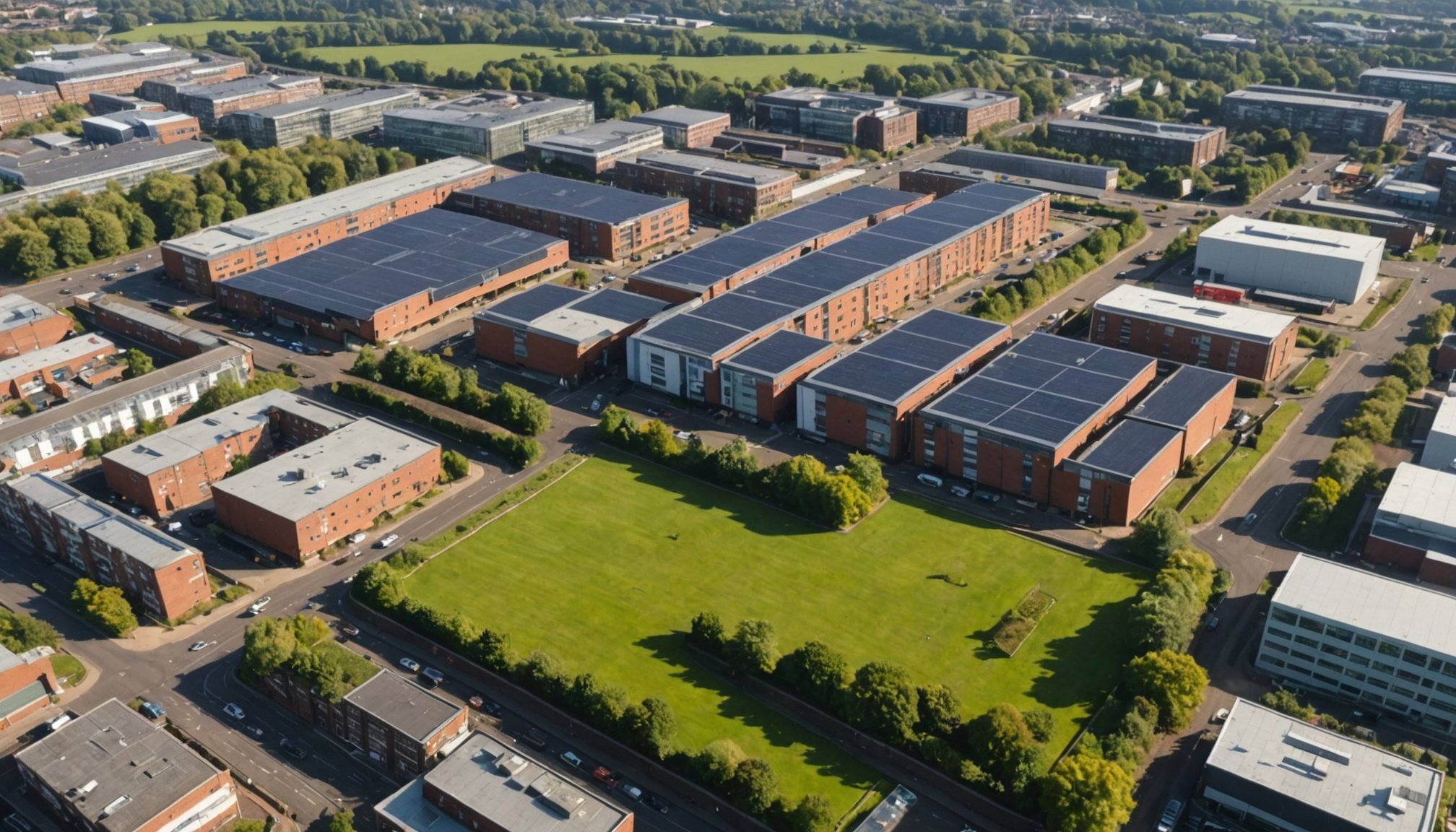Overview of Carbon Reduction Strategies in the UK Building Sector
Carbon reduction in the UK building sector is critical for sustainable development and environmental preservation. It involves implementing innovative strategies to decrease carbon dioxide emissions produced during construction and operation. The sector actively adopts various approaches to mitigate its carbon footprint, emphasising sustainable materials and energy efficiency.
Key methods include the integration of advanced materials designed to enhance insulation and the use of recycled building materials. These strategies not only reduce carbon emissions but also promote resource efficiency, benefiting both the environment and the economy.
Also read : Revolutionizing urban school air quality: creative approaches for a healthier future in uk cities
Policies and regulations play a significant role in guiding these efforts. The UK government has introduced stringent building regulations to ensure that sustainability and carbon neutrality are prioritised. These regulatory frameworks compel the adoption of energy-efficient technologies and sustainable practices, ensuring compliance and encouraging the industry to innovate.
Overall, the emphasis on carbon reduction in the UK building sector is a multifaceted effort driven by technology, innovation, and policy. By focusing on enhancing sustainability, the sector aims to contribute significantly to the overarching goals of reducing carbon emissions and achieving a net-zero target in the near future.
In parallel : Transforming culinary packaging: cutting-edge strategies to reduce plastic waste in the uk
Technological Innovations
The building sector is witnessing a remarkable transformation with the incorporation of technological innovations that drive sustainability. These innovations not only enhance construction efficiency but also contribute significantly to carbon reduction.
Advanced Materials
A key aspect of modern construction technology involves the utilisation of sustainable materials. These materials are engineered to be eco-friendly, reducing the overall carbon footprint of buildings. Innovations in insulation materials have been pivotal, providing superior thermal efficiency and reducing energy consumption. Additionally, the use of recycled building materials conserves resources, contributing to a circular economy and further reducing emissions.
Smart Building Technologies
Smart buildings leverage the integration of Internet of Things (IoT) in their management systems. These advanced technologies allow for precise energy management and optimisation, leading to enhanced efficiency. Data analytics play a critical role, offering insights that help in minimising energy consumption and boosting sustainability. Such smart solutions enable buildings to operate responsibly, aligning with stringent carbon reduction goals.
Renewable Energy Integration
Integrating renewable energy sources into building designs is another progressive step in construction technology. The deployment of solar panels is increasingly common, harnessing clean energy to power buildings. Innovations in geothermal heating and cooling offer sustainable climate control solutions, while urban buildings explore wind energy applications, all contributing towards a greener future.
Policy and Regulatory Framework
Carbon reduction in the UK building sector is significantly influenced by building regulations and sustainability policies. To ensure carbon neutrality, the UK government has enacted a series of policies prioritising sustainable practices. One of the most impactful elements is the requirement for new constructions to adhere to stringent energy efficiency standards, compelling builders to integrate advanced technologies and materials.
The enforcement of building regulations has played a pivotal role in carbon reduction efforts. By mandating energy-efficient designs, these regulations help minimise emissions during both construction and the building’s operational lifespan. Compliance is not only essential but also encourages continuous innovation in construction methods to meet the evolving standards.
Successful implementations of these policies can be seen across the UK. For instance, certain urban developments have achieved impressive results by embracing sustainability policies that promote energy efficiency and resource conservation. These case studies often demonstrate how governmental support and regulatory frameworks drive positive outcomes, leading to notable reductions in carbon emissions.
Overall, the regulatory approach within the UK is designed to foster an environment in which sustainability is a key focus. By aligning industry practices with policy goals, the UK building sector is better positioned to achieve carbon neutrality.
Case Studies of Successful Projects
The _UK building sector* has seen numerous successful _case studies* demonstrating effective carbon reduction strategies. These projects illustrate best practices and offer valuable insights into achieving net-zero carbon emissions.
One noteworthy example is the BedZED (Beddington Zero Energy Development) project in London. BedZED showcases how innovative design choices can lead to significant carbon reduction. This eco-village utilises a combination of solar energy, energy-efficient building materials, and community-wide sustainability initiatives. As a result, it reduces electricity requirements by 45% compared to the average household.
Similarly, the Kingspan Lighthouse project, a prototype home in Northamptonshire, uses cutting-edge technologies to achieve carbon neutrality. Its implementation of insulation materials, solar thermal systems, and automated building management systems highlight the power of advanced construction technology in minimising emissions.
Such projects exemplify the success that can be achieved with robust planning and innovative strategies. By examining these case studies, industry leaders can draw lessons on the effectiveness of design choices and the importance of sustainable practices.
In analysing these achievements, it becomes clear that effective carbon reduction in the UK involves commitment, technological adoption, and strategic innovation, setting a benchmark for future undertakings.
Expert Insights and Interviews
In the pursuit of sustainability leadership, industry experts provide invaluable perspectives on the path forward for carbon reduction in the UK building sector. Interviews with industry leaders reveal the challenges faced in implementing new technologies. Despite these hurdles, their insights remain optimistic, highlighting a collaborative spirit aimed at overcoming obstacles.
A vital observation from these experts is the imperative of collaboration between sectors. By fostering partnerships, the industry can drive innovation and resource sharing. For instance, partnerships with academia and research institutions are pivotal in developing cutting-edge solutions tailored to the unique needs of sustainable construction.
Furthermore, there is a strong emphasis on engaging with local communities and stakeholders. This engagement ensures that the strategies employed are not only technologically advanced but also socially responsible. Such interactions build trust and promote widespread adoption of sustainable practices.
Industry leaders also predict that the next decade will witness significant evolution in carbon reduction strategies. With an increasing focus on innovative construction and emerging technologies, they anticipate an era of transformation where sustainability becomes the norm rather than the exception. As these expert opinions continue to shape practices, the UK building sector remains on track toward achieving its ambitious sustainability goals.
Future Trends in Carbon Reduction
As the UK building sector advances towards sustainability, several future trends promise to reshape how we approach carbon reduction. The sector is expected to embrace emerging technologies that significantly enhance building sustainability.
One such trend is the increasing adoption of innovative construction techniques, such as 3D printing and modular constructions, which minimize waste and improve efficiency. These methods not only reduce materials used but also expedite construction processes, thereby decreasing overall carbon emissions.
Evolving regulations and standards will also play a substantial role. As carbon reduction goals become more ambitious, regulatory frameworks will inevitably tighten. This necessitates the continuous adaptation of innovative strategies to meet these evolving compliance requirements.
A shift towards a circular economy is likely to influence construction practices. By emphasizing resource conservation and recycling, the industry can further mitigate its environmental impact. Using recycled materials and designing for disassembly will become integral components of sustainable construction.
Looking ahead, these trends signify a transformative era for the sector. Strategies will increasingly prioritize not only reducing emissions but also adapting to future sustainability challenges. The focus on innovative construction underscores a commitment to achieving carbon neutrality while pushing the boundaries of what’s possible in sustainable building.

